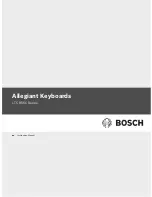
KDFX Reference
KDFX Algorithm Specifications
10-233
965 SRS
Licenced Sound Retrieval System
®
or SRS
TM
effect
PAUs:
1
The SRS
TM
algorithm has been licenced from SRS Labs, Inc. The following is from an SRS Labs press
release:
SRS, the Sound Retrieval System, is based on the human hearing system. It produces a fully immersive,
three-dimensional sound image from any audio source with two or more standard stereo speakers.
Whether the signal is mono, stereo, surround sound or encoded with any other audio enhancement
technology, SRS expands the material and creates a realistic, panoramic sound experience with no “sweet
spot” or centered listening position. SRS is single-ended, requiring no encoding or decoding, and uses no
arti
fi
cial signal manipulation such as time delay or phase shift to produce its natural, true-to-life sound
image.
The four SRS parameters control the ambience of the image, and may have different optimal settings
depending on the amount of stereo content in the inputs. To match the optimal settings speci
fi
ed by SRS
Labs, the bass and treble gains should be set to 0 dB. This algorithm will have no effect on mono signals.
Parameters
Page 1
In/Out
When set to “In” the effect is active; when set to “Out” the effect is bypassed.
Out Gain
The overall gain or amplitude at the output of the effect. Out Gain is not applied to the
signal when the effect is bypassed.
Center
The amount of “center channel” can be varied with this control.
Space
The width of the image is controlled with this parameter.
Bass Gain
The amount of ambience added to the Bass frequencies in the signals. A setting of 0 dB
gives a best match to the optimizations of SRS Labs.
Treb Gain
The amount of ambience added to the Treble frequencies in the signal. A setting of 0 dB
gives a best match to the optimizations of SRS Labs.
In/Out
In or Out
Out Gain
Off, -79.0 to 24.0 dB
Center
Off, -79.0 to 24.0 dB
Bass Gain
-79.0 to 24.0 dB
Space
Off, -79.0 to 24.0 dB
Treb Gain
-79.0 to 24.0 dB
Summary of Contents for K2661
Page 18: ...2 4 LFOs LFO Shapes...
Page 34: ...3 16 DSP Algorithms...
Page 54: ...5 4 MIDI Note Numbers Note Numbers for Percussion Keymaps...
Page 72: ...7 10 System Exclusive Protocol K2661 System Exclusive Implementation...
Page 82: ...9 4 Upgrading Sample Memory Choosing and Installing a SIMM for K2661 Sample Memory...
Page 334: ...10 252 KDFX Reference KDFX Algorithm Specifications...
Page 340: ...11 6 Glossary...
Page 382: ...12 42 Triple Modular Processing Alphanumeric Buttonpad Entries for DSP Functions...
Page 392: ...B 6 SysEx Control of KDFX MSB and LSB...
Page 442: ...D 20 Contemporary ROM Block Objects Controller Assignments Contemporary ROM Block...
Page 490: ...H 12 General MIDI Standard Mode Controller Assignments...
Page 492: ...I 2 Live Mode Objects Live Mode Programs...
Page 498: ...K2661 Musician s Reference Index...
Page 500: ......
















































